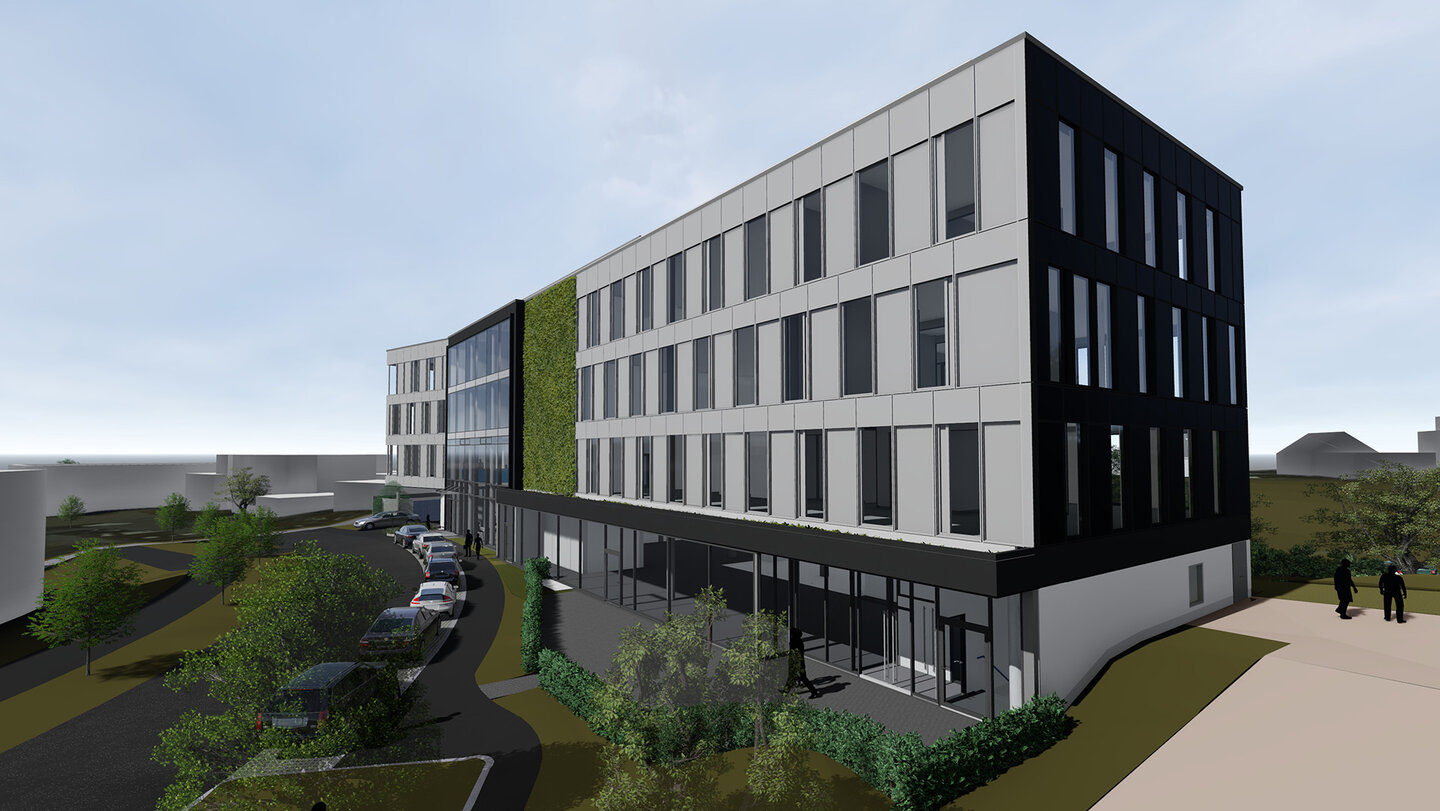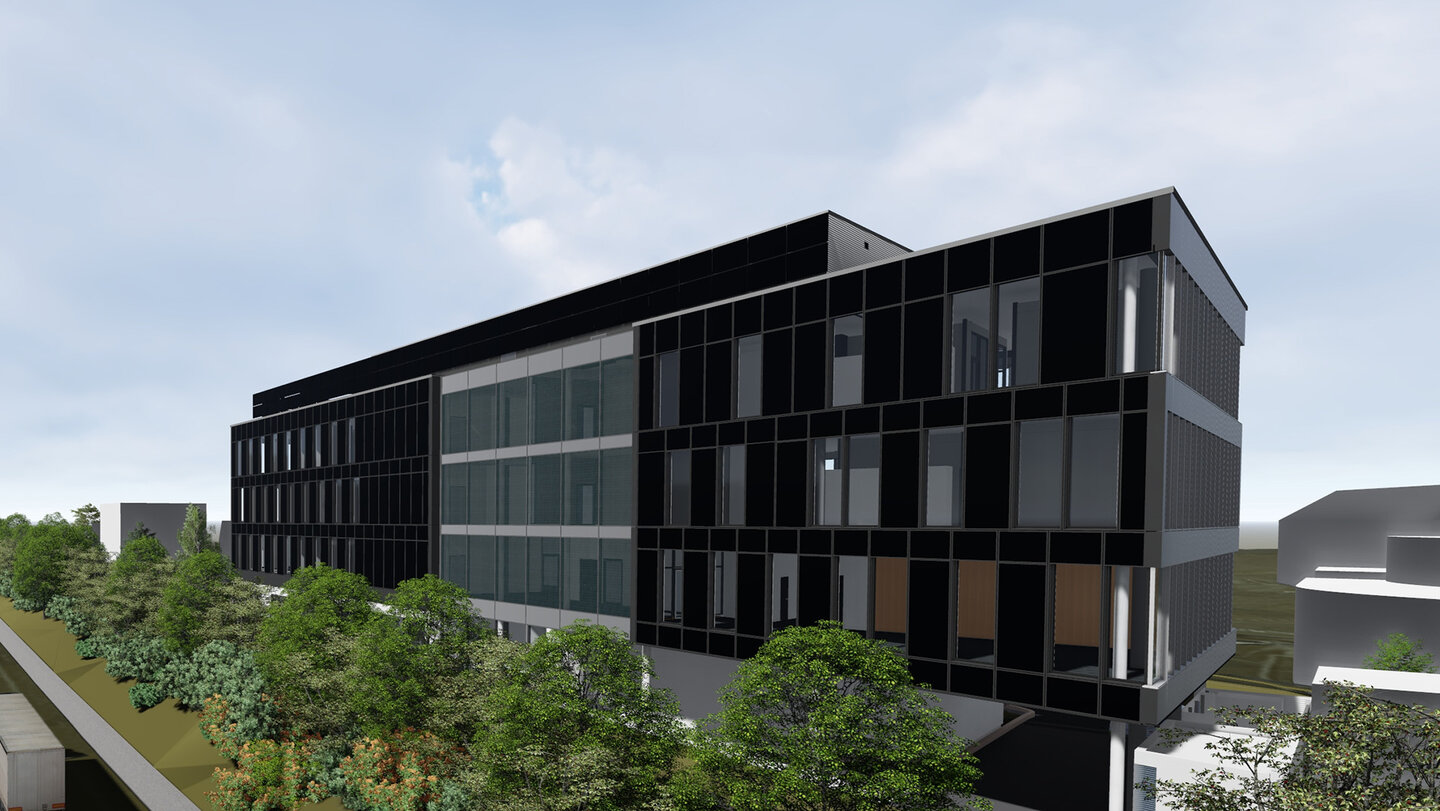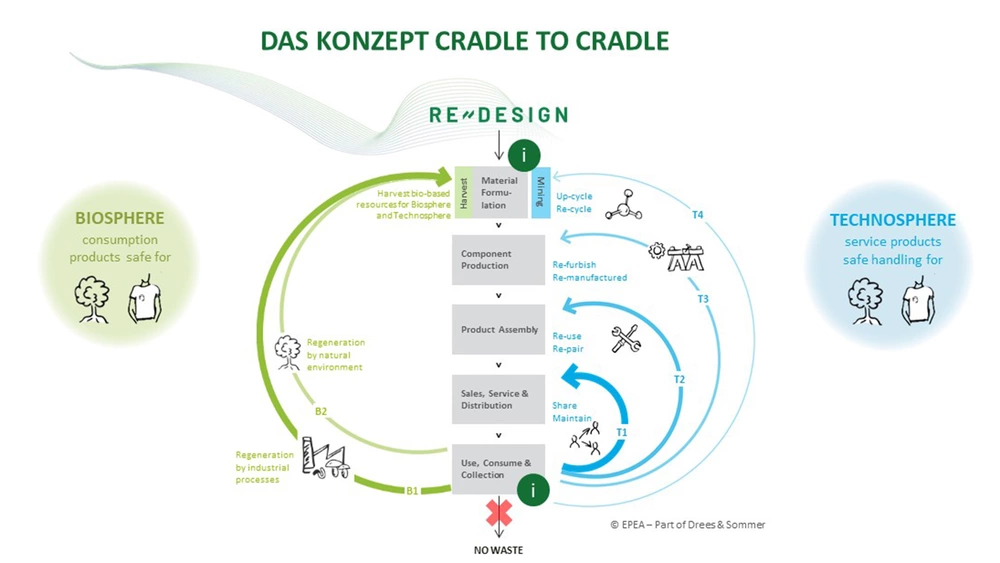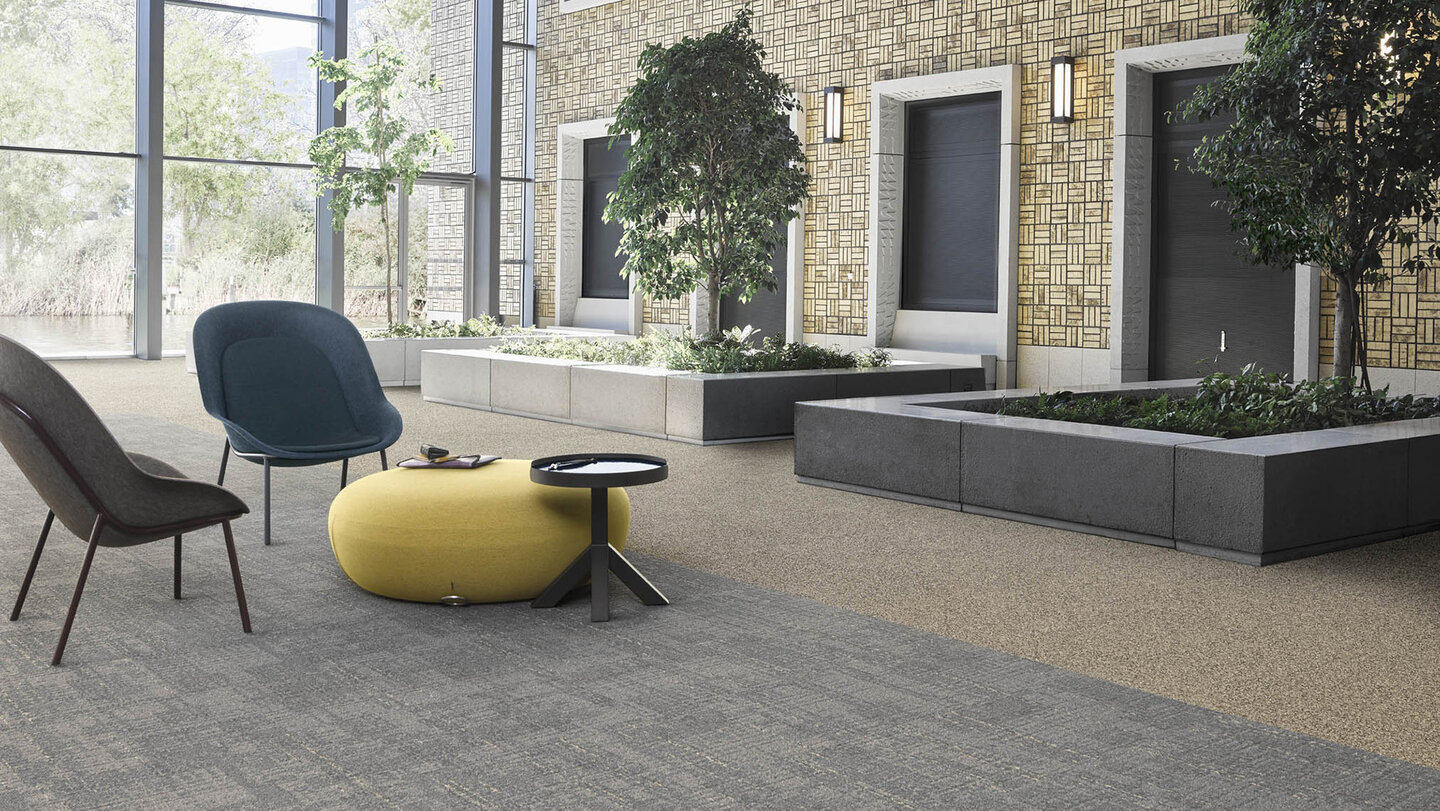Sustainable buildings aren’t just energy efficient. They’re made from natural and recyclable materials, which means that they consume fewer resources and lead to employees feeling better about their workplace. On top of that, there’s a chance of achieving lower construction costs through leasing models or deposit-refund schemes. With the office facing increasing competition from the home office, we shouldn’t underestimate the significance of sustainability.
By Peter Mösle, Partner at Drees & Sommer SE and Managing Director of EPEA – Part of Drees & Sommer

In 2021, Drees & Sommer moves into a new workspace with a new, heavily-insulated façade, solar panels on the roof and the south wall, geothermal energy supplied through pipes in the earth and a north façade covered with greenery. The building conforms to an energy-plus standard, meaning that it generates more energy than it actually uses and which is one of the requirements of the Cradle to Cradle principle. It also features state-of-the-art digital equipment.
Drees & Sommer is investing 22 million euros into the four-storey tower, which extends over a gross floor area of around 7,000 m². It will feature a huge conference area, chill-out areas for employees like a terrace, a cafeteria and a canteen for up to 1,000 workers, and desks for 200 employees. Designed by SCD Architekten Ingenieure in Stuttgart, the building is a far cry from being functional and institutional. It aims to get employees looking forward to coming into work (and provide an attractive alternative to working from home over the long term). In addition, it serves as a real-life model for companies thinking about construction projects. After all, if Drees & Sommer is to give clients advice on how to build digitally, flexibly and efficiently, what could be better than putting our money where our mouth is?

Drees & Sommer’s new office building in Stuttgart is as good for the environment as it is for employees’ health. Beside its sustainability credentials, it also provides a safe and healthy work environment for approximately 200 workers.
"If you want to tell people what to do and what makes business sense, it’s best to put your money where your mouth is."
Meanwhile, sustainability has become a strategic priority for many companies and it’s natural that they want to approach this holistically, both inwardly and outwardly. Obviously, the office buildings are a highly visible manifestation of this. This makes offices a vanguard of brand identity as well as being an important tool for attracting talent. And from a talent acquisition point of view, the coronavirus crisis hasn’t changed a thing.
Employees’ health and well-being is an important part of this equation. Sustainability poses a lot of challenges, many of which require a high level of inventiveness, plus plenty of upstream research into the types of materials to be used and consideration of which planning specialists to bring on board. It’s also important to bear in mind that sustainability is about more than being as energy efficient as possible – it also involves material selection and health and well-being. Drees & Sommer’s new building in Stuttgart addresses both aspects, employing green, plant-covered façades and natural materials such as clay walls and carpets made out of recycled materials. This should also have a positive impact on the air quality in the office and workers’ productivity. The products and materials used are all recyclable and will retain value after the end of their life cycle. They can also be easily disassembled with existing user guides.

This is all based on the Cradle to Cradle design principle, according to which the consumption of resources and waste should ideally be reduced to nil and materials used are considered to be “nutrients”. Buildings and the materials employed in buildings are selected on the basis either that they are completely bio-degradable or they can be repurposed – in the construction industry, they are mostly recycled in so-called technical cycles. To satisfy these requirements, the right system and product design need to be in place, and the materials’ chemical composition needs to be such that they don’t release any harmful elements into recycled goods and the environment later on. In short: the circular economy relies on healthy building materials which is where measures like material certifications and an overall building material passport come in.
Whilst interdisciplinary research teams are currently working hard on material cycles, manufacturers and producers are applying concepts like Cradle to Cradle to develop waste-free, recyclable and compostable building materials. More and more construction firms are getting on board and architecture and planning firms are being challenged to incorporate recycling and positive sustainability into their projects. In a parallel to the 1970s when the oil crisis suddenly put energy onto the agenda, the industry as a whole – including construction firms – is focused on the development and utilization of recyclable materials. And just like energy consultants came to the fore back then, a new class of professionals called circular engineers or material planners is now being drafted into planning teams to work on these challenges with architects and constructors. If the construction and property industries want to make a real contribution to climate protection and saving resources, all roads seem to lead to the circular economy.

The number of building products that conform to the C2C principle is constantly increasing. You can find C2C-certified products for floor coverings, partitions (including glass partitions), and types of insulation and façade.
The Cradle to Cradle design principle also has a direct impact on the people using the buildings. We have already seen (in real examples like the town hall in Venlo) that companies that set up offices in sustainable buildings have lower incidences of illness and a lower turnover of employees. In a nutshell: if you feel comfortable at your workplace then you do not fall sick that often and have fewer reasons to look for a new job.
Sustainability can also be factored in once buildings are commissioned. The kind of smart technology that will be used in Drees & Sommer’s flagship new offices in Stuttgart will control systems to save energy and reduce operational and ancillary costs. A mobile app will enable access credentials to be assigned, conference rooms and parking places to be booked, and heating, ventilation and light to be configured automatically for every user.
"If you feel comfortable at your workplace then you do not fall sick that often and have fewer reasons to look for a new job."
However, from the perspective of global business, it’s important to have comparable, cross-border standards of quality, which is why we need a catalogue of international criteria. With international standards in place, properties would need to be built not just with sustainability in mind, but also with the aim of being certified. This is important from an investment point of view because the market value of a certifiably sustainable building is higher than properties without accreditation.
There are already three industry-recognized standards for green buildings: the American LEED (Leadership in Energy and Environmental Design), the British BREEAM (Building Research Establishment Environmental Assessment Method) and the German DGNB (Sustainable Building Council) seal. Nowadays, practically all new buildings have at least one of these standards, all of which aim to provide information about efficiency, ecofriendliness and resource consumption, and whose certification offers an independent perspective on quality.
Companies know what they can expect from certified properties, not just in terms of energy consumption and water efficiency but also air quality in office spaces and transport connections. Thinking about circular recycling, the 2018 DGNB standard offers a system of sustainability certification where some elements of the circular economic model have already been integrated.
 © Tarkett Holding GmbH
© Tarkett Holding GmbH
Sustainable products like Cradle to Cradle-certified carpet floor tiles by Desso, which create healthier room environments, will become more widespread in the workplace of the future.
Almost all of the new buildings in Germany’s commercial centres have adopted ‘green building’ as an important – even indispensable – benchmark for quality, and the next generation of healthy, recyclable and digital buildings is already in the pipeline. The high-value retention of green buildings, EU laws on taxonomy and social pressure have pushed green issues and sustainability up the agenda. After all, at a time when towns are calling climate emergencies and movements like ‘Fridays for Future’ are fighting for more environmental protection, scarce a day goes by when climate change and the future of our planet isn’t on the agenda; and the pressure to act is growing. Without any other credible means of guaranteeing a future for our grandchildren, energy efficiency, renewables, a positive carbon dioxide footprint and Cradle to Cradle design will be paramount. There’s plenty at stake, but office users will also benefit from sustainability. We will all have modern, sustainable and health-promoting buildings and workspaces to look forward to. And that’s exactly what Drees & Sommer’s employees will be getting when they move into the next-generation building in Stuttgart.
Peter Mösle (Dr.Eng) Partner at Drees & Sommer SE and Managing Director of EPEA – Part of Drees & Sommer
Since 1996, Peter Mösle has helped countless national and international building projects become green buildings. Professionally, he focuses on the areas of energy design, energy management and the development of sustainable districts. As the Managing Director of EPEA GmbH – Part of Drees & Sommer, he also champions and pioneers the Cradle to Cradle principle within the construction sector.
Peter Mösle is a member of the DGNB executive committee and is the chair for the area of system development and sustainable urban districts. He finished his studies in mechanical engineering (with a specialisation in energy technology) at the University of Stuttgart and Tucson, US, and earned a doctorate from the University of Stuttgart in 2009.
Dossier "The Workplace Reloaded”

The corona pandemic has suddenly brought us face to face with issues – such as digitization and sustainability – that the construction sector would have had to address sooner or later anyway. Whilst it's clear that the office itself is still relevant, what will it actually look like? What will characterize the offices of the future, which aspects will be important for the workplace in the future and for everyone connected with it, is the subject of numerous articles and interviews in our dossier "The Workplace Reloaded".